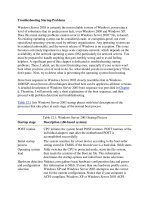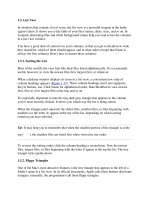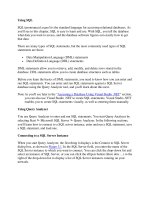Zoos and Animal Welfare Phần 1 doc
Bạn đang xem bản rút gọn của tài liệu. Xem và tải ngay bản đầy đủ của tài liệu tại đây (1.04 MB, 11 trang )
Zoos and
Animal Welfare
Zoos_ITCY_v5.qxd 11/5/07 5:31 PM Page 1
Other books in the Issues That
Concern You series:
Discrimination
Drunk Driving
Electronic Devices in Schools
Gun Violence
Medical Marijuana
Obesity
Student Drug Testing
Zoos_ITCY_v5.qxd 11/5/07 5:31 PM Page 2
Zoos and
Animal Welfare
Christine Van Tuyl, Book Editor
Christine Nasso, Publisher
Elizabeth Des Chenes, Managing Editor
Zoos_ITCY_v5.qxd 11/5/07 5:31 PM Page 3
© 2008 Gale, a part of Cengage Learning
For more information, contact
Greenhaven Press
27500 Drake Rd.
Farmington Hills, MI 48331-3535
Or you can visit our Internet site at gale.cengage.com
ALL RIGHTS RESERVED.
No part of this work covered by the copyright hereon may be reproduced or used in any form
or by any means—graphic, electronic, or mechanical, including photocopying, recording, taping,
Web distribution or information storage retrieval systems—without the written permission of
the publisher.
Articles in Greenhaven Press anthologies are often edited for length to meet page requirements.
In addition, original titles of these works are changed to clearly present the main thesis and to
explicitly indicate the author’s opinion. Every effort is made to ensure that Greenhaven Press
accurately reflects the original intent of the authors.
Every effort has been made to trace the owners of copyrighted material.
Zoos and animal welfare / Christine Van Tuyl, book editor.
p. cm. — (Issues that concern you)
Includes bibliographical references and index.
ISBN 978-0-7377-3818-6 (hardcover)
1. Zoo animals. 2. Zoos—Philosophy. 3. Animal welfare. 4. Animal rights.
I. Van Tuyl, Christine.
QL77.5.Z673 2009
590.73—dc22
2007036344
LIBRARY OF CONGRESS CATALOGING-IN-PUBLICATION DATA
ISBN-10: 0-7377-3818-9
Printed in the United States of America
1 2 3 4 5 6 7 12 11 10 09 08
Zoos_ITCY_v5.qxd 11/5/07 5:31 PM Page 4
Introduction 7
1. Animals Suffer in Captivity 12
The Captive Animals’ Protection Society
2. Animals Do Not Suffer in Captivity 18
The Philadelphia Zoo
3. Elephants Do Not Belong in Zoos 24
In Defense of Animals
4. Elephants Are Thriving in Zoos 29
The Association of Zoos and Aquariums
5. Elephants Are Better Off in Sanctuaries 34
The Elephant Sanctuary in Tennessee
6. Elephants Are Not Necessarily Better Off 39
in Sanctuaries
Michael Hutchins and William Conway
7. Surplus Animals Are a Big Problem 46
People for the Ethical Treatment of Animals
8. Surplus Animals Are Being Dealt With 51
Jesse Donahue and Erik Trump
9. Zoos Play a Key Role in Education 58
The Wildlife Conservation Society
10. Zoos Do Not Play a Key Role in Education 63
Dale Jamieson
11. Captive Breeding Programs Contribute to 69
Conservation
The Association of Zoos and Aquariums
CONTENTS
Zoos_ITCY_v5.qxd 11/5/07 5:31 PM Page 5
12. Captive Breeding Programs Are a Failure 75
Animal Rights Malta
13. Zoos Have a Bright Future 80
Jeffrey P. Bonner
14. Zoos Should Be Abolished 87
Mercy for Animals
Appendix
What You Should Know About Zoos and Animal Welfare 93
What You Should Do About Zoos and Animal Welfare 96
Organizations to Contact 101
Bibliography 105
Index 108
Picture Credits 112
Zoos_ITCY_v5.qxd 11/5/07 5:31 PM Page 6
Melbourne, Australia, and the New York City Zoo. In 1889 the
U.S. Congress established the National Zoo for the purpose of
breeding native wildlife.
Zoos Today
Today there are more than four hundred professionally managed
zoos across the globe. In addition, there are thousands of roadside
menageries and petting zoos. Every year more than one hundred
million people visit a zoo in the United States, generating mil-
lions of dollars of revenue. Studies show that 98 percent of
Americans have visited a zoo at least once in their lifetime.
Most major zoos in the United States are accredited by the
Association of Zoos and Aquariums (AZA.) The AZA is the driv-
ing force of zoo advancement and requires that all members adhere
to strict animal care standards. In addition, all AZA-accredited
zoos must pursue the tenets of education, research, and conserva-
tion. While many zoos of the past merely strived to be entertain-
ing, today’s zoos have evolved into a greater role, educating the
public about different species of animals and enticing them to
take part in conservation efforts.
Today’s zoos certainly differ greatly in appearance from zoos of
the past. Visitors to zoos can recognize major changes in zoo
exhibits. For the most part, small concrete cages have evolved
into large habitat enclosures more reminiscent of each animal’s
natural environment. The San Diego Zoo, for example, is a pio-
neer in building “cageless” exhibits and features many different
animals and plants in the same exhibit that would be found side
by side in nature, such as the zoo’s simulated Asian rain forest,
Tiger River. On the other side of the country, the Bronx Zoo’s
Congo Gorilla Rainforest sprawls over 6.5 acres (2.6ha) and grows
thick with trees, bamboo, and other lush landscape. This exhib-
it is home to more than fifty-five wildlife species and twenty west-
ern lowland gorillas.
Some zoos have even made changes to the types of animals they
will house in their exhibits. The Philadelphia Zoo, for example,
has decided to close its elephant exhibit, as elephants are not suit-
8 Zoos and Animal Welfare
Zoos_ITCY_v5.qxd 11/5/07 5:31 PM Page 8
ed for cooler climates, and the Bronx zoo is also phasing out its
elephant exhibit.
Animal welfare advocates, however, argue that zoos will never
be suitable homes for wild animals and keeping them in captivi-
ty is never in the animal’s best interest. They claim that most zoo
Introduction 9
Zoos help animals like the bald eagle get off the Endangered
Species List.
Zoos_ITCY_v5.qxd 11/5/07 5:31 PM Page 9
animals still reside in outdated exhibits that are far smaller than
their natural habitats, resulting in repetitive, stereotypical behav-
iors called “zoochosis,” such as pacing, swinging, and rocking.
Animal welfare advocates argue that this repetitive, apparently
senseless behavior indicates neurosis or even insanity, and is caused
by loneliness, frustration, stress, and psychological and habitat dep-
rivation.
Zoos of Tomorrow
Most zoo experts contend that as plants and animals continue to
die off at alarming rates, zoos will grow in importance as centers
for conservation. Many zoo supporters argue that zoos are the only
beacon of hope in the race against extinction. According to reports
from the World Conservation Union, human activity threatens
99 percent of all species. Another study says that a quarter of the
world’s plant and vertebrate animal species will face extinction
by 2050.
The zoo community already celebrates several conservation
success stories, including the reemergence of the California con-
dor, black-footed ferret, American alligator, grizzly bear, and wild
bison. There are also success stories for the Guam rail, Przewalski’s
horse, scimitar-horned oryx, and Spix’s macaw. Zoo supporters
contend that many other species can be saved from extinction by
captive breeding inside zoos.
Many animal welfare advocates, however, argue that conserva-
tion is just a guise to hide the real nature of zoos as profit-driven
organizations. They note that animals bred in captivity are rarely
returned to the wild, and worse yet, some animals are the name-
less, faceless victims of the zoo “business” which often ends up
with more animals than it can care for. Some of the “surplus” ani-
mals are killed by zoo management in “cullings,” while others are
sold to animal dealers, research laboratories, poorly managed road-
side zoos, or canned hunting ranches.
Can animals live a happy and healthy life inside zoo walls, or
should they live in the wild? Will zoos be able to transform them-
selves to respond humanely to global extinctions, or are zoos sim-
10 Zoos and Animal Welfare
Zoos_ITCY_v5.qxd 11/5/07 5:31 PM Page 10
ply an idea whose time is gone? The potential consequences that
zoos hold for the welfare of animals is one of the topics explored
in this book. In the following excerpts from magazine articles, edi-
torials, books, and other sources, the authors debate the merit of
zoos and their evolving role in our world. This book also features
several resources to help readers understand the controversy sur-
rounding zoos and animal welfare, including organizations to con-
tact, a list of additional articles and books on the subject, and a
list of facts about the topic. The appendix “What You Should
Know About Zoos and Animal Welfare” offers advice to help read-
ers conduct their own research, form an opinion, and take action.
With all these features, Issues That Concern You: Zoos and Animal
Welfare is a great place to start researching this controversial and
fascinating topic.
Introduction 11
Zoos_ITCY_v5.qxd 11/5/07 5:31 PM Page 11









